WelCom June 2020:
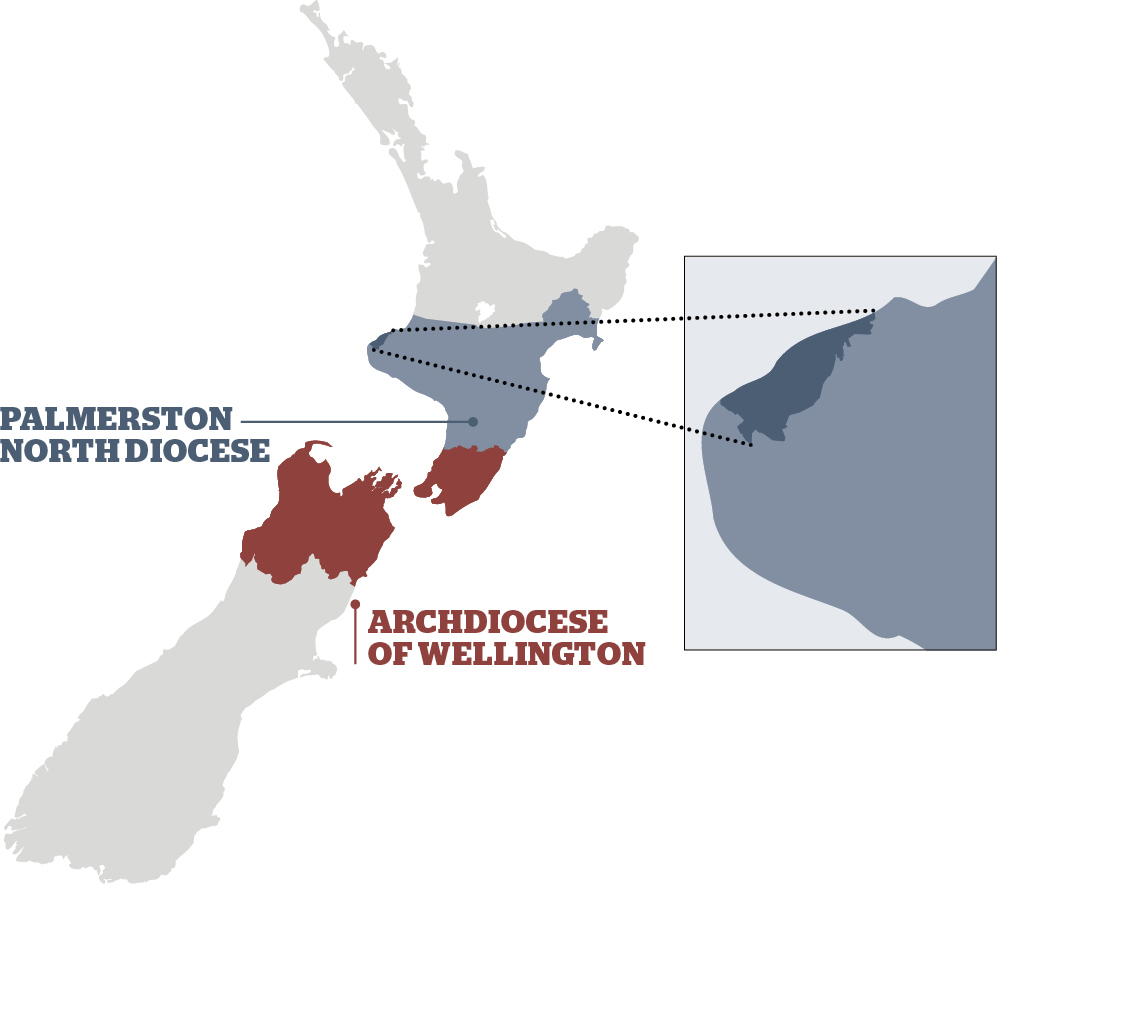
WelCom’s Hīkoi of Faith this month journeys to The Parish of New Plymouth – Te Pārihi Katorika Ki Ngāmotu. The parish encompasses St Joseph’s Church and St Joseph’s School, Our Lady Help of Christians’ Church and St John Bosco School, Bell Block Centre, St Patrick’s Church, Okato, St Pius X School, Sacred Heart Girls’ College, and Francis Douglas Memorial College. Parish priest is Fr Simon Story, assisted by Fr Tom Lawn, Fr Vui Hoang, the parish team of five staff and the parish leadership team.
New Plymouth is a major city of the Taranaki Region on the west coast of the North Island. The New Plymouth District is the 10th largest district in New Zealand with a population of around 75,000. This includes New Plymouth City, Waitara, Inglewood Ōakura, Okāto, and Urenui. The area is known for Mount Taranaki, the coastal walkway from Bell Block to Port Taranaki with its spectacular views, surfing and fishing, botanical gardens, birdlife, subalpine forests and waterfalls in the Egmont National Park, art galleries and major music events. The city is a service centre for the region’s intensive pastoral activities – mainly dairy farming – as well as oil, natural gas and petrochemical exploration and production.
Originally called Ngāmotu (the islands), the site of New Plymouth was occupied for hundreds of years by Māori. More than 60 pā and kāinga (village) sites have been recorded in the urban ares. Photos: Supplied
Early History
Ireen Crossan, Parish Secretary
The establishment of the Catholic Church in Taranaki began later than in many other parts of New Zealand – closely linked to the relationship between Māori and Pakeha and the development of the province. During the 1850s the Diocese of Wellington was formed and the Society of Mary moved into the area. In 1852, Fr Jean Pezant sm was assigned to Whanganui – an area from Manawatu to Mokau in the North Taranaki. Each year, he visited New Plymouth with just 40 or 50 Catholics in the European population. Evangelical mission with the Māori community had not yet begun. In 1855 the arrival of the 58th and 65th Regiments brought the Irish and Catholic men who asked the Bishop for the services of a priest. A small church for 30 people was built in Courtney St, New Plymouth. In 1859, as tension between Māori and Pakeha grew, reinforcements of troops arrived in the city. Fr Tresallet was sent from Whanganui to found a mission station with responsibility for Taranaki, from Waitotara in the south to Mokau in the north.
With the end of hostilities in 1869, Marist priests could focus on the parish. A monastery was built at Koru near Oakura. A second church, a new presbytery and in 1879 a bell christened Ambrosius became part of the Devon St site.
In 1880 the parish connection with the Society of Mary ended. Fr Chastahnon, a Frenchman, was appointed to the parish. He invited the Sisters of the Mission to New Plymouth, beginning the relationship between school and parish. A three-storey convent was built next to the church – one of the many Catholic schools built in the parish. In 1884 the first Irish priest, Fr Cassidy, arrived.
Inglewood, Waitara, Stratford and Okato were part of the parish. In 1899 Stratford became a parish, and Inglewood followed in 1912. Okato came under the care of the Society of Mary when a Māori Mission was established there and later joined with St Martin’s Pungarehu. In 1950 St Joseph’s parish Waitara was established.
By 1951, the parish covered only the city and outlying areas. As the city grew so did the Catholic population. From 1951 to1956 the number of Catholic residents increased from 2731 to 3626. In 1951 of Our Lady Help of Christians Parish in Fitzroy was established. In 1959 St Philomena’s Parish in Brooklands was established.
After 100 years, the original Taranaki mission area had formed into 12 separate, distinct parishes and St Joseph’s New Plymouth now covered just central and western New Plymouth being served by four priests. It was a time of growth. But church life changes as society changes and changes stemming from Vatican 2, urban living, transportation, demographics and the number of priests available, all reflected on St Joseph’s parish.
Our Focus is Mission
Fr Simon Story, Parish priest
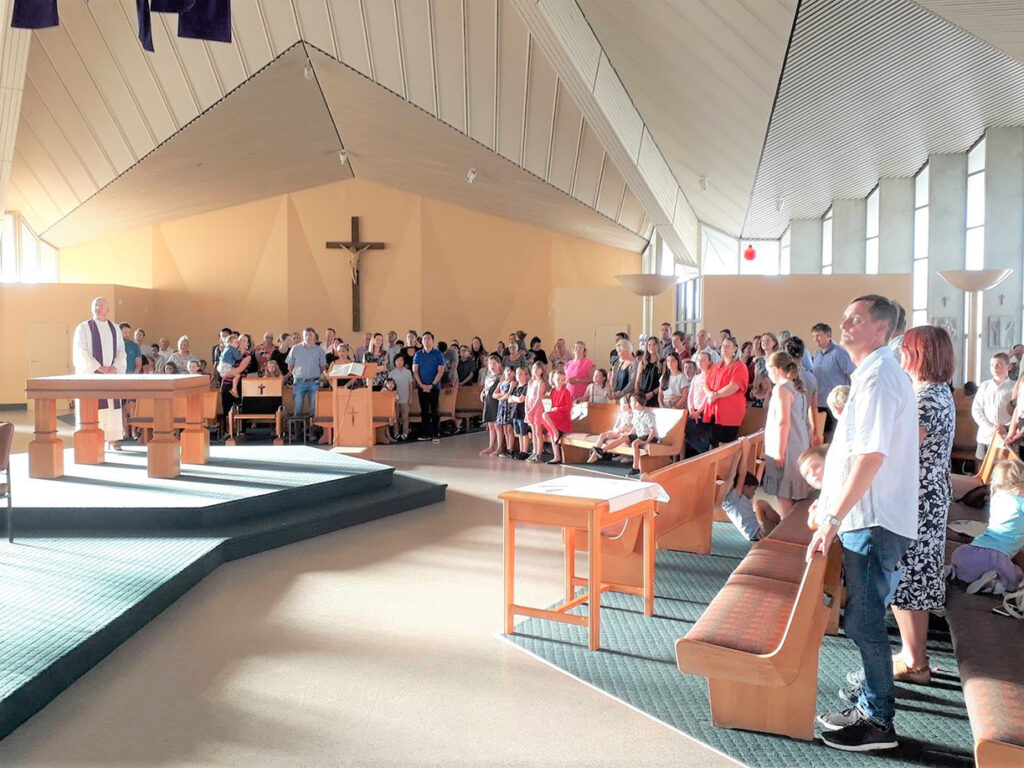
The New Plymouth Parish – and Taranaki generally – have a somewhat ‘different ethos’ to the rest of the Diocese of Palmerston North. Traditionally it has strong participation and engagement from parishioners. The five Catholic schools in New Plymouth are full and one hundred children celebrate first communion annually. While this strength can still be felt, the parish has suffered from the effects of post-modernity (‘does Church work for me?’) and the growing secularity of New Zealand – most people now register as non-religious.
We have enjoyed the arrival of migrant communities to the parish. Indian, Filipino and Pasifika peoples have reminded Māori and European that our tīpuna arrived here not that long ago. The integration of migrant communities has encouraged an inclusiveness and changed the look of the faith community. The Leadership Team of the parish, following amalgamation to a city-wide parish, has needed to consolidate and develop parish property and buildings. This has been a big job. Amalgamation brought greater collaboration between faith communities and reduced the doubling-up of groups and committees. People resources are more available. We have managed to form a great ministry team with three priests and five parish staff. The parish focus has moved to mission. The making and building of missional disciples of Jesus Christ within a Catholic tradition, yet open to the varied people that arrive among us is our new kaupapa.
Parish life in the 1980s and 1990s
Fr Tom Lawn, Emeritus Parish Priest
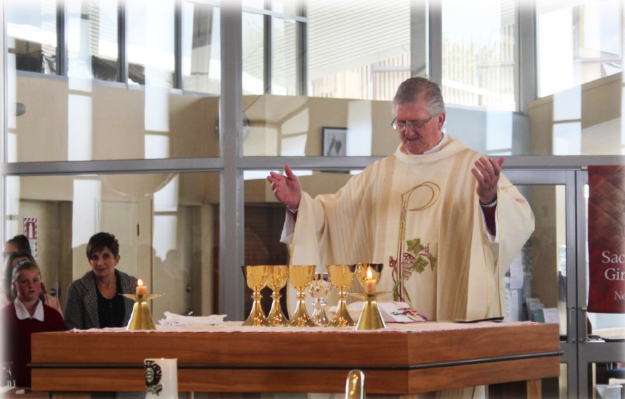
In 1987 I was appointed back to Taranaki, my home province, to be assistant priest at St Joseph’s – the largest of the three parishes of New Plymouth, the others being St Philomena’s and Our Lady Help of Christians.
St Joseph’s was a thriving parish with a Parish Council, Finance Committee, Liturgy Committee, many Renew groups, prayer groups and circles, sacramental programmes and an amazingly strong ministry to the sick and housebound on Sundays. Mons Tom Duffy, Fr Pat Loft and I served St Joseph’s Church and St Paul’s Church, Spotswood communities.
In 1988 I was appointed parish priest with the assistance of Pat.
The Renew cycle was coming to an end and it was time to start thinking about where to from here. We decided to invite the Passionist Family Group movement to speak to our Parish. Passionist priests and leaders from St Mary’s Whanganui came and spoke at Masses. The decision was made that would be the way to strengthen our parish further. At one point there were about 15 groups.
Another decision we made was to challenge parishioners to: attend Sunday Mass; participate in a Ministry (serving our community) or an Apostolate (serving beyond to the wider community we lived in); and belong to a small parish group (a Family Group, Women’s League, Vincent de Paul, etc).
One of our better decisions was to invite the Presentation Sisters to set up a community in Marfell, a poor suburb. This was going to stretch our budget by about $13,000. We informed the parishioners and guess what our annual income rose by – that amount. It still amazes me.
Also running were ‘Hands On’ and ‘Exploring the Liturgy’ education programmes. A hunger to learn brought new vitality to our parish. Out of ‘Exploring the Liturgy’ came the celebration of Rite Three of Reconciliation. These Liturgies in Advent and Lent would have more than 500 penitents. The sense of belonging was enhanced by The Josephite, a quarterly publication that kept everyone abreast of parish life from births through to deaths. During those years ‘Family Centred Programme’ sheltered the families whose children did not attend Catholic schools.
We priests – me and six others – over 21 years, tried really hard to make sure everyone knew they were the parish and we were bringing gifts to enrich their parish. We came and went but pretty much they carried on being parish. We priests were also ministers of Sacraments to St Philomena’s, and Sacred Heart, Inglewood parishes as priest numbers decreased.
One of the hardest decisions was the closing of St Paul’s Church, still a source of pain for some parishioners. Another was the re-ordering of St Joseph’s Church. The liturgy education many had participated in, enabled it to be a whole parish effort. There was much tossing and turning, fierce debates at public meetings, but the re-ordering got done, the money was raised. Some of us were and are very proud of it, some of us not so.
In 1997 one of the little quirks of fate is through amalgamation I became parish priest of my home Church of St Patrick’s Okato, the community and church I grew up in. The Mission Sisters gave up their August holidays each year to come and educate us ‘country heathens’.
The Catholic communities of Taranaki are solid, we have been enriched by waves of migrants, Irish, Swiss, Polish, Dutch, petroleum industry workers from many countries, families from the Pacific Islands and now from the Phillipines and India. They have blessed us and now they are us and we are them.
Journey to the united Catholic Parish of New Plymouth
Michelle Scharre and Mark Poppelwell, Parish leadership team co-chairs
In October 2013, Bishop Charles Drennan asked then parish priest Fr Craig Butler to reunify St Joseph’s Parish of New Plymouth City, Our Lady Help of Christians Parish of Fitzroy and St Philomena’s Parish of Brooklands, into one ‘Catholic Parish of New Plymouth’. Fr Craig was charged with forming a steering group ‘to be co-responsible with the parish priest for the leadership, form and shape of the Church in New Plymouth’ and ‘to lead the process, vision and outcome’.
Fr Craig approached representatives of the three parishes – from Okato to Bell Block and Egmont Village – to jointly develop the vision, structure and movement to a ‘full mission of the Church in New Plymouth’.
The steering group members included Michelle Scharre, Sr Mary Wyss, Kingsley Sampson, Gerald Wells and Mark Poppelwell, supported by Heather Butler, and later joined by Fran Butler and Colin Fromon. Mark Richards from the Palmerston North Diocese Centre provided regular advice.
The reunification process was intended to bring about a ‘flourishing and alive Church in work, prayer and liturgy; community; formation and education; and service to the poor and those in need’. A draft a transitional plan was to be completed for the bishop’s approval by Easter 2015.
A comprehensive engagement process involved everyone from the North Taranaki Catholic community and included schools, chaplaincies and ethnic communities. The process highlighted parishioners’ emotional attachment to the Church and the services they attended. Many were worried Masses would be reduced or that their church would no longer be open, especially the community of St Philomena’s whose church had burnt down in January 2014. The process also highlighted to many the extensive ‘behind the scenes’ work done by the parish priest, office staff and the many volunteers.
After two years of planning and weekly steering-group meetings the draft transitional plan was ready. It included recommendations for a new organisational structure, more support for clergy, more administrative support for the financial, personnel and health and safety obligations of the sizeable Catholic organisation, and more pastoral support for the parish.
The proposal was formally approved by Bishop Drennan in June 2015. In September 2015, the parishes of St Joseph’s, St Philomena’s and Our Lady Help of Christians became one – The Catholic Parish of New Plymouth.
A special Mass to mark the amalgamation’s first anniversary was held the following year at the TSB Stadium, led by new parish priest Fr Simon Story and attended by hundreds of parishioners. Fr Simon said the joining up of the three parishes was seen as a way to strengthen the Catholic faith in the city and the special Mass was a way to recognise that and to celebrate unity.
Today we are the unified Catholic Parish of New Plymouth, where Frs Simon Story, Vui Hoang and Tom Lawn provide for the communities at Bell Block, Okato, Fitzroy, Brooklands and New Plymouth.
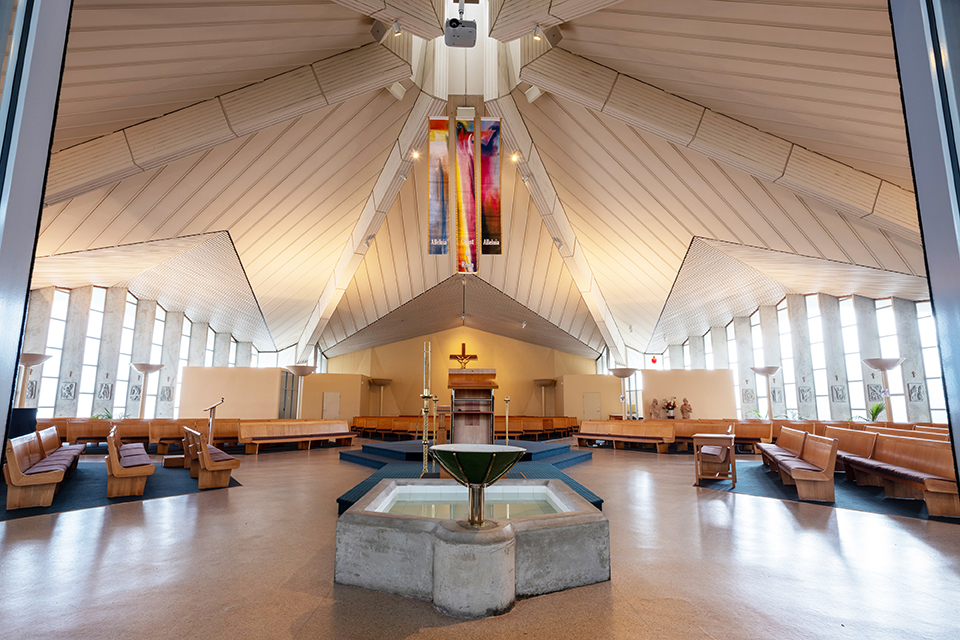
St Joseph’s Church, New Plymouth City. 
Parishioners at St Philomena’s Church, Brooklands (gutted by fire, 2014). 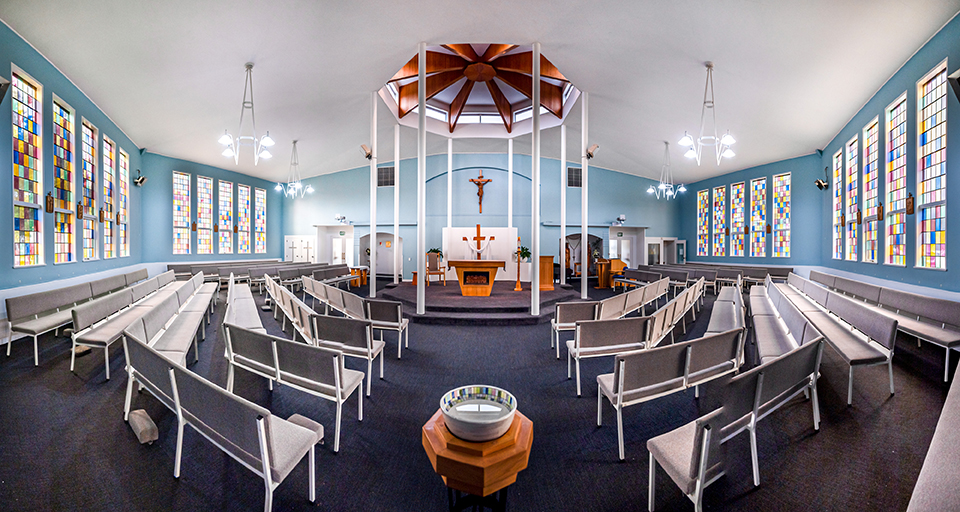
Our Lady Help of Christians’ Church, Fitzroy.
Okato Community
Marian Richardson
Okato is a small rural town about 25 minutes’ drive South around the coast from New Plymouth on State Highway 45. St Patrick’s Okato, was first established in 1880 and the first church built in 1881. In the mid-1890s, Okato became a centre for the Marist priests and the Taranaki Māori Mission. A large two storied presbytery was built next to the church and was the centre of the Mission until the presbytery was burnt down in 1947.
For many years our parish was joined with St Martin’s Pungarehu [42km south-west of New Plymouth and near Parihaka Pā]. A priest was located in Pungarehu attending to the spiritual needs of coastal families in both the Pungarehu and Okato areas. In the 1990s, as the shortage of priests grew, we were disestablished as a joint parish and became a separate parish working under the umbrella of St Joseph’s in New Plymouth. We were supported by Sr Veronica and Fr Frank Garty in his retirement.
In more recent times our sacramental needs have been sustained by the priests from St Joseph’s and St Patrick’s ran as an independent parish keeping in close contact with our fellow parishioners in Pungarehu.
In 2015 St Patrick’s was amalgamated with the newly formed Catholic Parish of New Plymouth. Even though our Mass times were similar, the biggest change for us as a community was giving up our own autonomy as a parish. The St Patrick’s community still provides sacramental programmes for our children when necessary and the church has become a popular choice for young couples who want a traditional church wedding.
Within the Okato community our church is represented in the annual Christmas Parade and the Christmas Vigil is well attended by coastal families and visitors. Our community is small and acceptance for change is growing but we feel fortunate to be an active faith community within the Catholic Parish of New Plymouth.
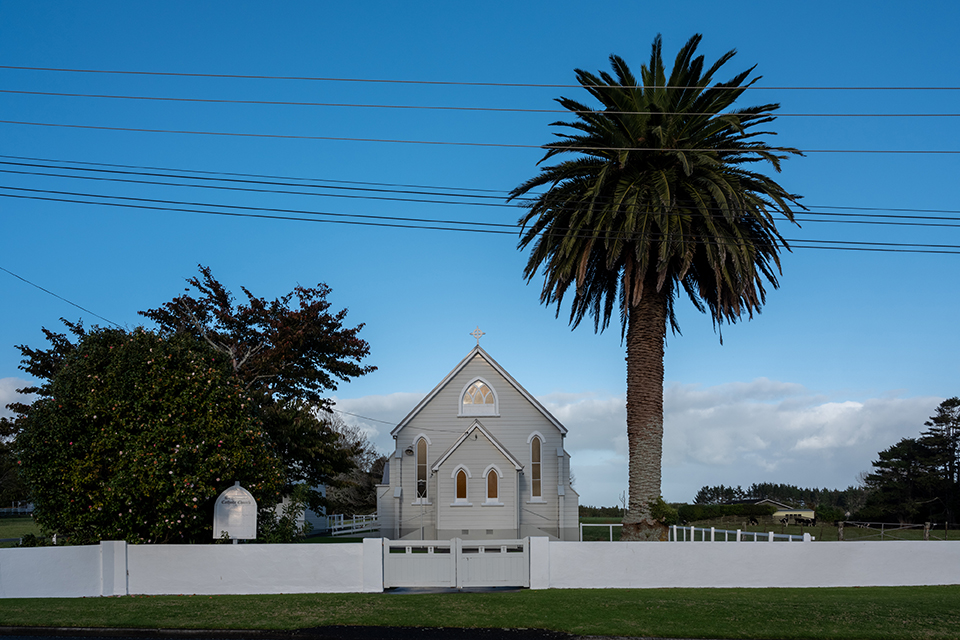
St Patrick’s Church, Okato. 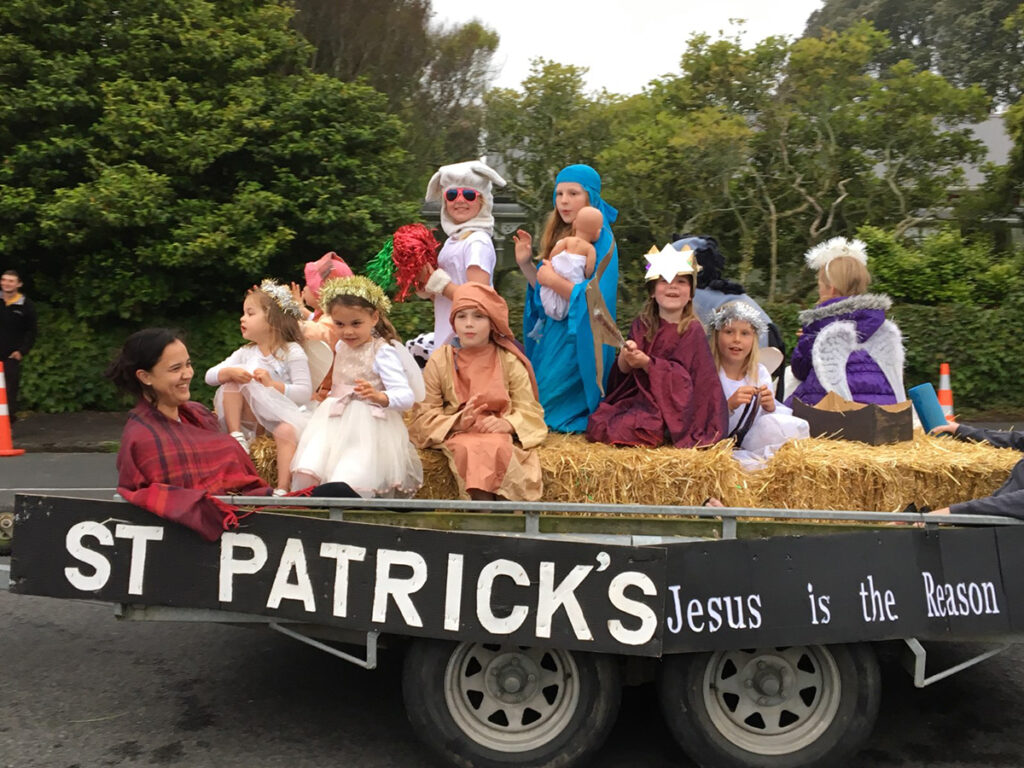
Parish children in the Okato Christmas Parade.
Bell Block Community
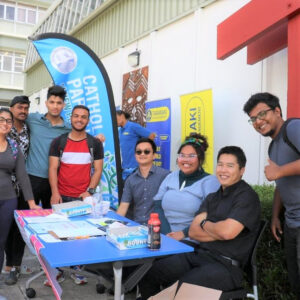
The Bell Block Catholic Centre in the northern suburb of New Plymouth was built under the guidance of Fr Wally Cooke in 1979 as part of the then Our Lady Help of Christians’ Fitzroy Parish. This coincided with expansion of Bell Block housing area as part of the Petro Chemical ‘think big’ projects at that time. The church was built on land donated to the parish by Jack and Nora Barry. The original plan was for the building to be the forerunner of a church to be built on adjacent land.
The Assumption Sisters were involved for some years in the community as was Fr Jim Rickard in his retirement years. Initially there were 80 to 90 parishioners, mainly younger families. Over the years this has changed to a mixture of older people including from a number of retirement villages, migrant families as well as overseas students from the nearby Pacific International Hotel Management School. A consistent feature has been Samoan families who have contributed over the years particularly with their wonderful singing.
Ever since it’s opening there was a regular Sunday Mass until 2019 when the shortage of priests forced a change to one Mass a month and Liturgy of the Word with Communion on one other Sunday.
Bell Block is a vibrant community that has a strong network and sense of support for each other.
Young Families Ministry
Michelle Butler
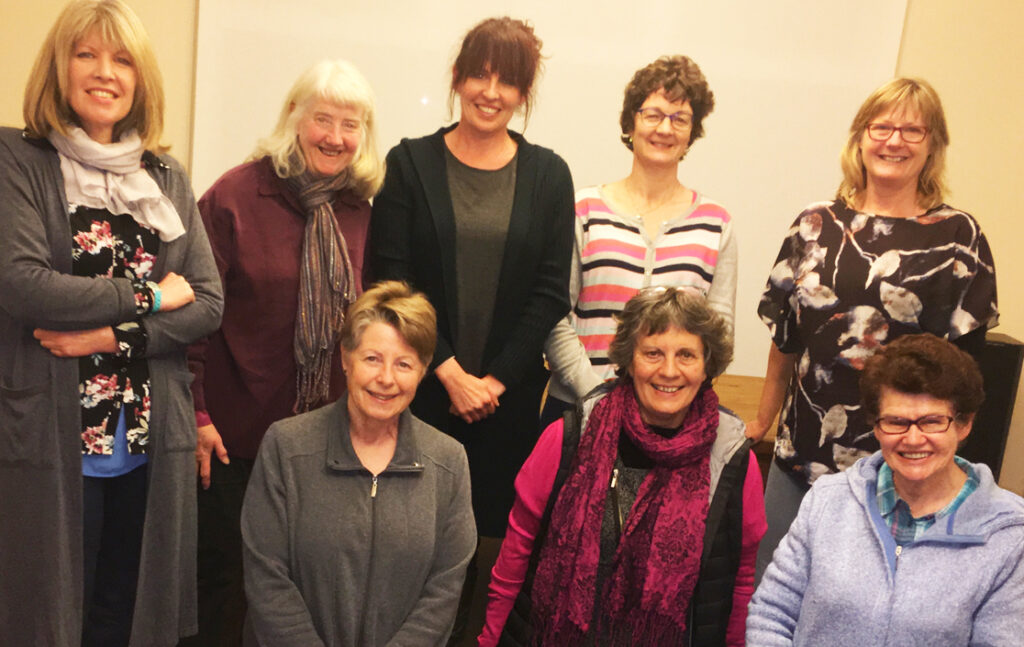
In 2018 a new part-time young family minister role was established in the parish to help develop more connections for young families in our faith community with children up to 12 years old. Largely this has been through coordinating our sacramental programmes across the parish as well as a parish-wide programme. Last year there were over 170 children connecting through First Sacrament preparation – not including infant Baptism. Maintaining these connections is an ongoing challenge! The ministry presents many possibilities and has led to the development of a Mum’s playgroup, regular Year 7/8-led Masses, increased linking with our Catholic schools and children’s liturgy groups, and support of family Masses such as at Christmas.
Involvement and ideas are always welcomed as the role develops to meet the needs of our Parish – engagement of our young families now will help shape the future of our Parish!
Youth Ministry


Hika Perez
I joined the Catholic Parish of New Plymouth as full-time Youth Minister in August 2018 to serve young people and to help them build a relationship with Christ. Our first youth group attracted just five teens and we now have 15 to 25 gathering weekly at our Sunday youth group.
Our monthly community meals, which we prepare and cook for people in need, have Catholic and non-Catholic youth from all the secondary schools helping our outreach. Through our networks we have distributed food and self-care packages to Taranaki secondary schools and community groups in need.
Since coming into the Ministry role, when I first met some of the teens from New Plymouth, many of them seemed unfamiliar with a youth group and Church staff. After spending time together through service and prayer, I have witnessed them grow in confidence and a sense of belonging. Regular Youth Masses have enabled many to shine, using their gifts of singing or speaking in public.
Hospital Chaplaincy
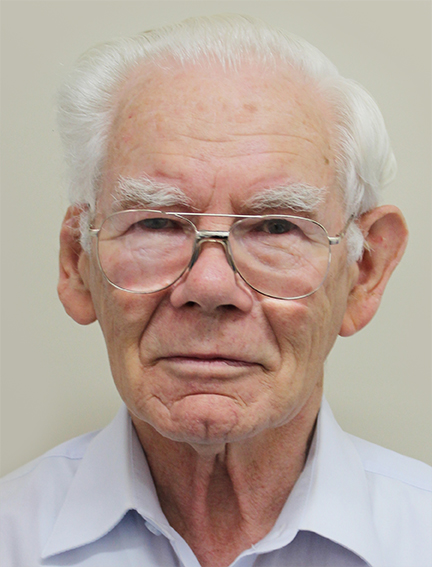
Tony Tooman.
Hospital Chaplaincy in the New Plymouth Parish is a team effort, which contributes towards the wellbeing of patients in the Taranaki Base Hospital. In the first place the priests of this parish are only too willing to drop everything and go to the hospital at any hour to anoint those who are seriously ill.
The appointed Catholic Chaplain is Tony Tooman who has been in this role for the past 16 years. He visits the hospital every second day and offers spiritual and emotional support. He endeavours to contact all who are admitted as Catholics and also tries to support others.
A group of volunteers, known as Ecumenical Chaplaincy Assistants, regularly visit the wards two hours a week. About six of these people come from the parish and provide valuable assistance to the chaplains.
Mass is celebrated in the Hospital Chapel of the Good Shepherd on the first Saturday of each month, during which the Sacrament of the Sick is Administered. Mobile patients who wish to attend are assisted by helpers and up to 50 parishioners are regularly welcomed.
Francis Douglas Memorial College – New Plymouth
Martin Chamberlain, Principal
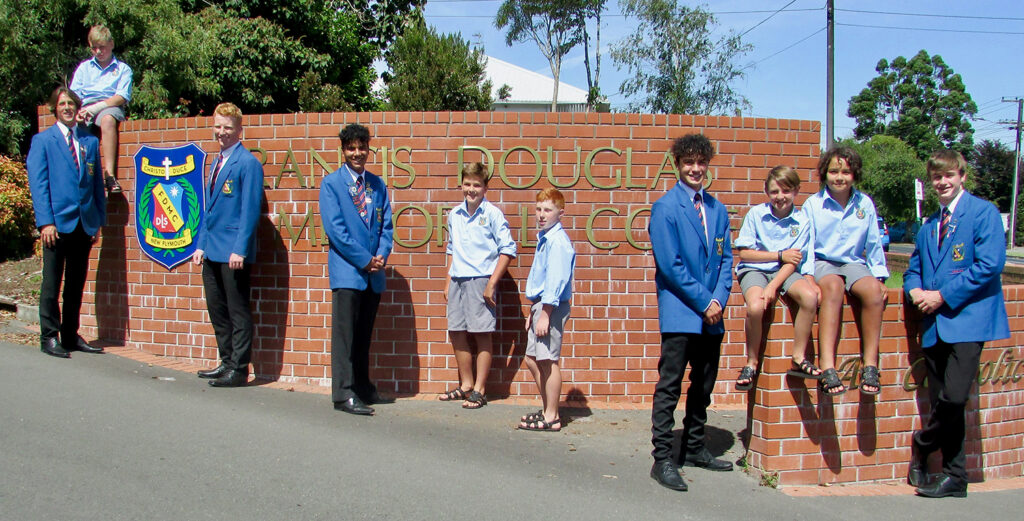
Counter culturally to those times, since 1884, the Taranaki province cherished Sacred Heart Girls’ College as its secondary school for young Catholic women but had no equivalent for boys. Instead, they attended a local state secondary school or travelled to Sacred Heart Auckland or St Patrick’s Silverstream. That all changed in 1959 when local fundraising come to fruition with the opening of Francis Douglas Memorial College and its boarding school. The College took its name from a Columban priest who worked in New Plymouth and then died a martyr’s death as a missionary priest during the Second
World War.
The school was staffed by the De La Salle order who generously gave 68 of their serving brothers until their exit in 2009. They remain the school’s faithful proprietors to this day.
Today’s school hosts 785 students from Years 7 to 13 – 110 boarders among them. Among our five school values are Faith in the Presence of God and Concern for the Poor and Social Justice. These attributes are manifest in the Good College Man whom we aim to produce. Our boys’ brotherhood among each other, their fundraising for charity and politeness, all contribute to an atmosphere where members of staff and students are brothers and sisters to each other and our boys are respected as well rounded and respectful young people who seldom disappoint.
Among our better known alumni are: Anthony McCarten – international screenwriter; Michael Kelly – Cambridge physics professor; Patrick Gower – journalist; Steven Joyce – MP; Sean Kelly – fashion designer; Mons Brian Walsh; Br Peter Bray – Vice Chancellor Bethlehem University; Jim Hickey – weather forecaster; Shane Anselmi – founder of Overland Footwear; Tim Naish – Director of Antarctic research at Victoria University; as well as a host of sportsmen including Frank van Hattum, Michael Aish, John Mitchell, Conrad Smith, Liam Coltman and the famous trio of Barrett brothers.
Sacred Heart Girls’ College, New Plymouth
Paula Wells, Principal
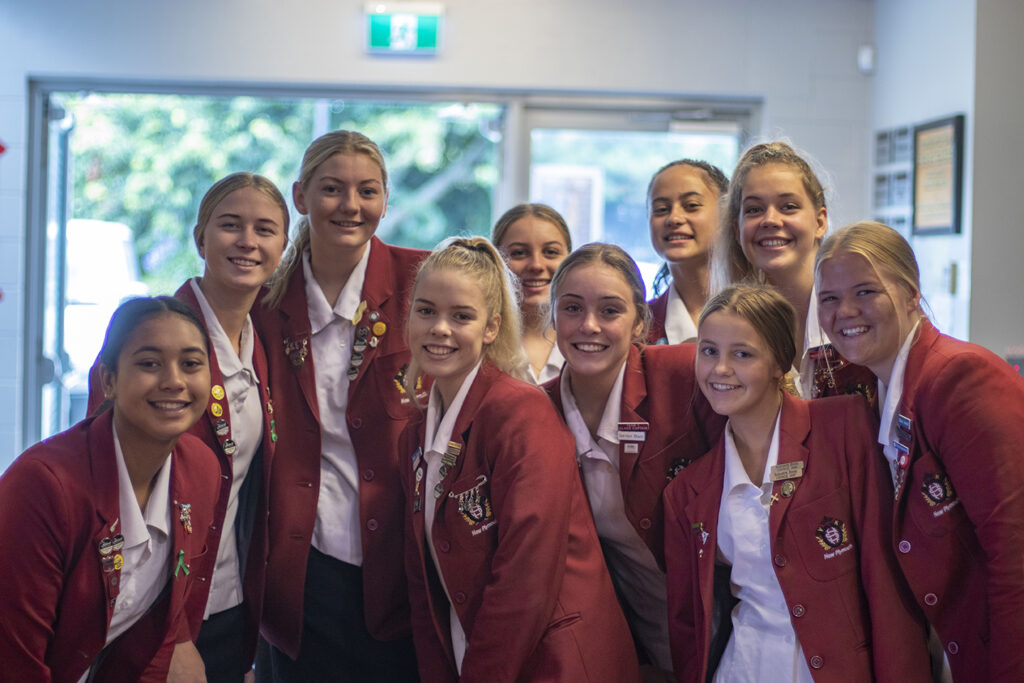
Sacred Heart Girls’ College, New Plymouth, was founded by Euphrasie Barbier in the tradition of the Sisters of Our Lady of the Missions in 1884. The original school building was located on Powderham St, adjacent to St Joseph’s Church and catered for 25 boarders. Initially the school was a private school for girls but was integrated in 1975. The current campus, located at the end of Pukaka St in Fitzroy, was opened in 1961. The Mission College New Plymouth Trust Board is the Proprietor of the college, which shares its grounds with its hostel, Elizabeth House, and Adele Senior Living.
Sacred Heart, Manawa Tapu, is at capacity with 710 students and a full boarding hostel that houses 84 students who hail from rural Taranaki and King Country. The college buildings and grounds are modern and fit for purpose and are under constant improvement thanks to its prudent Trust Board. Preference enrolment is consistently exceeding capacity, leading the Board of Trustees to be applying to the Ministry of Education for a Maximum Roll Increase twice in the past three years.
Culturally, the college has established and embedded its Manawa Mission, in that it celebrates and lives the mission gifted to it by the Mission Sisters through Ako, Manaakitanga and Wāhine Toa. They Live the Mission through Ako in taking every opportunity to learn, through Manaakitanga in respecting and loving one another and through Wāhine Toa in respecting and loving oneself, and in doing so growing into strong, independent, resourceful and resilient young women who form and maintain reciprocally respectful relationships.
This Christo-centric culturally responsive Mission college maintains a strong tradition of exemplary student achievement, with every student celebrated for their God-given gifts and talents across a myriad of co-curricular and extra-curricular opportunities. It recently has held the national titles for both ShowQuest and the 123 Tech Challenge and has numerous current national sporting representatives.
Manawa Tapu is the modern living embodiment of the Mission Sisters’ ethos: Age Quod Agis – everything you do to the best of your abilities.
St Joseph’s School, New Plymouth
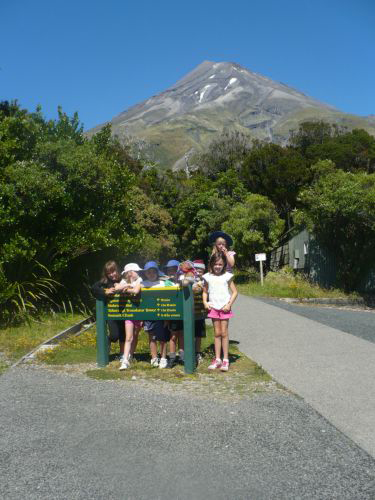
St Joseph’s School, New Plymouth – also known as Heidelberg in its early years – was founded by the Congregation of Our Lady of the Missions and officially opened on October 24, 1926, by the late Archbishop Redwood.
The school consisted of four classrooms. An infant room was added in 1938. Fatima Hall was built on the school grounds in 1950 and was used as a Mass centre and later as an additional classroom.
In 1962 two new classrooms were built to accommodate the ever-increasing numbers enrolling and in 1964 a further two classrooms were added. Since 2009, Fatima Hall has been developed into two classrooms and another four classrooms have been built. The maximum roll is 310 children. The roll has been at 310 for the last few years and future enrolments indicate the school will continue to have a full roll.
We recently updated our school Mission Statement to:
‘He kura manaakitanga, he kura whakapono ki Hehu Karaiti, kahikitia te mātauranga, me te hauora o te tangata.’
‘Our Mission School, provides a genuine and ongoing encounter with Christ; strives for excellence in education and hauora for all.’
Our Gospel values support all that we do at St Joseph’s: Tika – Act Justly; Pono – Respect; and Aroha – Love.
Our competencies, ‘The 8 Cs,’ underpin our rich and broad curriculum, learning and teaching: Christian Living, Confidence, Communication, Critical Thinking, Creativity, Collaboration, Connected and Culturally Aware.
The school thrives on active integration with the local Catholic community and encourages parental involvement and support across all aspects of ‘school life’.
By Mike Dowd, Principal, Kate Landrigan and Hayley O’Neill, Co-Acting DRSs.
St John Bosco School, Fitzroy
Dee Luckin, Principal
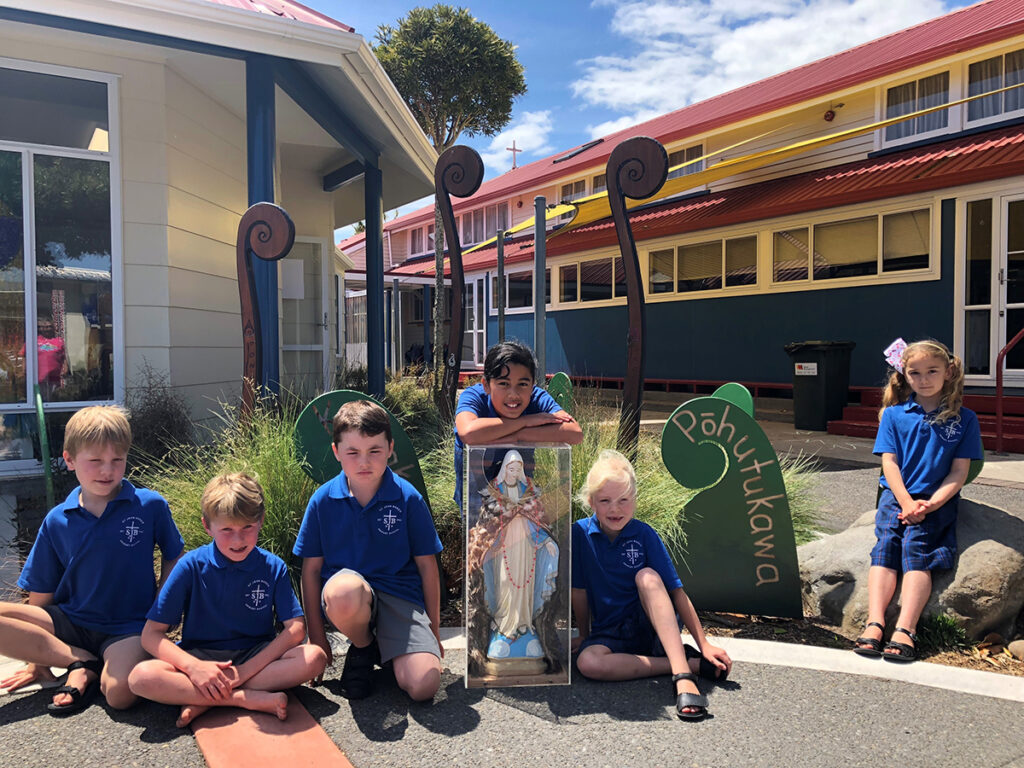
St John Bosco School’s history dates back to 1920. Known as the ‘Old School’, a homestead owned by the Cameron family was the first place where the Sisters of the Mission began their teaching. There were two classrooms and the house was also used as a Mass centre for the people of Fitzroy. The Cameron family sold the land and house to the Catholic Church towards the end of the 1920s.
The school roll was growing around this time, so garden parties and concerts were held to raise funds for a new school building. In 1942 the new St John Bosco School was opened. It was also used as a Church on Sundays. In 1958 Our Lady Help of Christians’ Church was built next to the school. There is a proud history of our founders, with the Sisters of the Mission teaching or being involved in the school up until integration
in 1983.
Our Patron Saint John Bosco was a natural leader and held a special talent of working with youth. He became a champion for young boys guiding them to success. John Melchior Bosco (1815–1888) was an Italian Catholic priest, educator, and writer of the 19th century. Inspired by John Bosco our school vision is ‘Focused Foundations and Faith for the Future’. Being the only St John Bosco School in New Zealand brings about a sense of special pride.
Since 1942, the school roll has steadily grown to a maximum roll of 275 children today and is at full capacity. Over the years building projects have taken place with new classrooms, libraries and administration spaces being added. In 2016 the Palmerston North Catholic School Board began modernisation of the entire school. This was completed at the beginning of 2020 and the school now boasts 12 classrooms and beautiful flexible learning spaces.
St John Bosco School belongs to the combined Ngāmotu Parish. Our church, Our Lady Help of Christians, stands beautifully at the end of Clinton St in Fitzroy. Reconciliation, Holy Communion and Altar Serving programmes are still facilitated with our school community. We continue to have and are supported by the resident priest, currently, Fr Simon Story, living onsite in the Parish House.
St Pius X School, Brooklands
Anna Wormald, Principal, and Anne Dent DRS
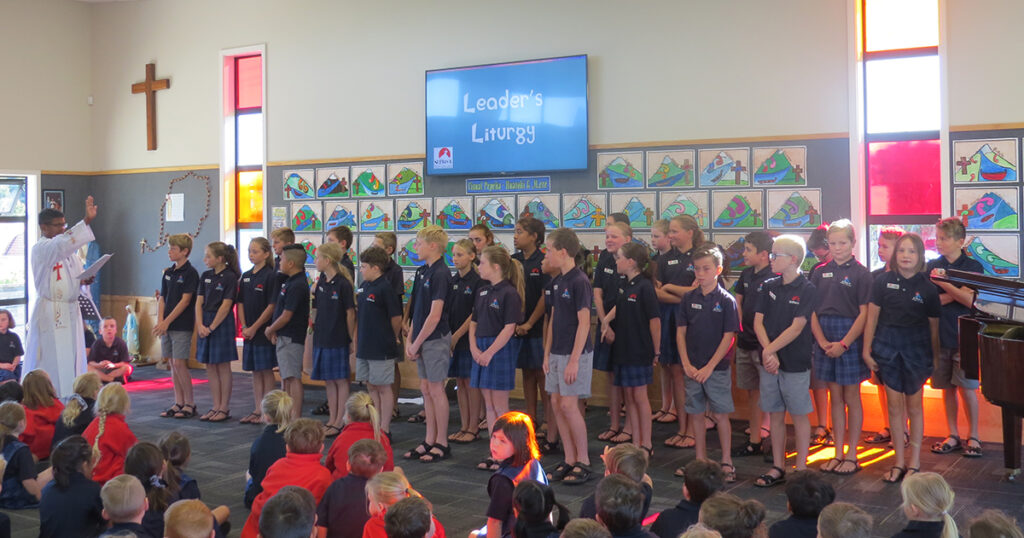
St Pius X Catholic School opened on 7 February 1952, with a roll of 75 pupils, and was staffed by the Sisters of St Joseph of the Sacred Heart. The order was lovingly known as the ‘Josephites’ or ‘Brown Joes.’ The school consisted of three classrooms with the two main rooms having folding doors, which were opened for Mass. Every Friday the older children moved out the chairs and desks and Saturday saw two parishioners moving in the pews for Sunday Mass in what was known as the Mass Centre.
On 8 December 1959, the Brooklands Parish received notice they were to become a parish in their own right. Preparation to build a church began immediately. St Philomena’s Church was opened on 1 September 1963.
At the end of 1981 the Brown Josephite’s withdrew from Brooklands Parish and St Pius X School. The Sisters of the Mission took over the great work the Brown Josephites had begun in 1952. The school was integrated into the state system on 29 September 1982. Sr Mary Wyss was the school Principal at that time and the last Religious Sister at the school.
Sadly, St Philomena’s Church was destroyed by fire, in suspicious circumstances, on 6 January 2014. A decision was made not to rebuild the church so in its place a new school hall was built and opened on 26 February 2017, named Philomena Hall.
St Pius X School community has a strong link with the parishioners of the Catholic Parish of New Plymouth. Staff and families of the school community are actively involved in parish life.
Today, the school has a maximum roll of 190 students from New Entrants to Year 6. There are eight learning spaces with 16 staff and support staff.
St Pius X School works hard to establish a community of faith and learning; one which recognises the uniqueness and dignity of the individual and operates on the Gospel Values. Our values are expressed through the charism of St Mary MacKillop.